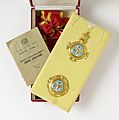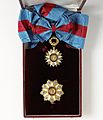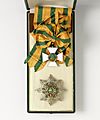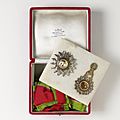Willem Drees facts for kids
Quick facts for kids
Willem Drees
|
|
|---|---|

Willem Drees in 1958
|
|
| Prime Minister of the Netherlands | |
| In office 7 August 1948 – 22 December 1958 |
|
| Monarch | Wilhelmina Juliana |
| Deputy |
See list
Josef van Schaik (1948–1951)
Frans Teulings (1951–1952) Louis Beel (1952–1956) Teun Struycken (1956–1958) |
| Preceded by | Louis Beel |
| Succeeded by | Louis Beel |
| Minister of Finance | |
| In office 1 July 1952 – 2 September 1952 Ad interim |
|
| Prime Minister | Himself |
| Preceded by | Piet Lieftinck |
| Succeeded by | Jo van de Kieft |
| Minister of Colonial Affairs | |
| In office 15 March 1951 – 30 March 1951 Ad interim |
|
| Prime Minister | Himself |
| Preceded by | Johan van Maarseveen |
| Succeeded by | Leonard Peters |
| Leader of the Labour Party | |
| In office 9 February 1946 – 22 December 1958 |
|
| Deputy |
See list
Dolf Joekes
(1946–1952) Marinus van der Goes van Naters (1946–1951) Jaap Burger (1946–1958) |
| Preceded by | Office established |
| Succeeded by | Jaap Burger |
| Deputy Prime Minister | |
| In office 25 June 1945 – 7 August 1948 |
|
| Prime Minister | Willem Schermerhorn (1945–1946) Louis Beel (1948) |
| Preceded by | Hendrik van Boeijen (1942) |
| Succeeded by | Josef van Schaik |
| Minister of Social Affairs | |
| In office 25 June 1945 – 7 August 1948 |
|
| Prime Minister | Willem Schermerhorn (1945–1946) Louis Beel (1948) |
| Preceded by | Dolf Joekes |
| Succeeded by | Frans Wijffels |
| Leader of the Social Democratic Workers' Party |
|
| In office 14 May 1940 – 9 February 1946 |
|
| Deputy |
See list
Willem Albarda
(1940–1945) Jan van den Tempel (1940–1945) Marinus van der Goes van Naters (1945–1946) |
| Preceded by | Willem Albarda |
| Succeeded by | Office discontinued |
| Parliamentary leader in the House of Representatives |
|
| In office 10 August 1939 – 25 September 1945 |
|
| Preceded by | Willem Albarda |
| Succeeded by | Marinus van der Goes van Naters |
| Parliamentary group | Social Democratic Workers' Party |
| Member of the House of Representatives |
|
| In office 3 July 1956 – 3 October 1956 |
|
| In office 15 July 1952 – 2 September 1952 |
|
| In office 27 July 1948 – 10 August 1948 |
|
| In office 4 June 1946 – 4 July 1946 |
|
| In office 9 May 1933 – 25 June 1945 |
|
| Parliamentary group | Labour Party (1946–1956) Social Democratic Workers' Party (1933–1946) |
| Personal details | |
| Born | 5 July 1886 Amsterdam, Netherlands |
| Died | 14 May 1988 (aged 101) The Hague, Netherlands |
| Political party | Labour Party (1946–1971) |
| Other political affiliations |
Independent Social Democrat (from 1971) Social Democratic Workers' Party (1904–1946) |
| Relatives | Willem B. Drees (grandson) Jacques Wallage (grandson-in-law) |
| Alma mater | Amsterdam Public Trade School (B.Acc) |
| Occupation | Politician · civil servant · Accountant · Stenographer · Historian · Author |
| Signature | |
Willem Drees Sr. (born July 5, 1886 – died May 14, 1988) was an important Dutch politician. He was a member of the Social Democratic Workers' Party (SDAP). Later, he helped start the Labour Party (PvdA). Drees served as the Prime Minister of the Netherlands from August 7, 1948, to December 22, 1958. He was also a historian.
Drees studied Accounting at the Amsterdam Public Trade School. He worked at a bank and then as a stenographer for the Dutch Parliament. He became a Member of the House of Representatives in 1933. He focused on Social Affairs. During World War II, he became the leader of his party. After the war, he became Deputy Prime Minister and Minister of Social Affairs.
In 1946, Drees helped create the Labour Party and became its first leader. He led his party in several elections. After the 1948 election, he became Prime Minister. He led the country for over ten years.
Drees retired from politics at age 72. He continued to write and serve on government committees. He was known for being a good leader and manager. During his time as Prime Minister, his governments made many important changes. These included new laws for social security, welfare, Child benefits, and education. He also oversaw the independence of the Dutch East Indies (now Indonesia). His government also dealt with big events like the North Sea flood of 1953.
Drees was given the special title of Minister of State when he left office. He continued to share his thoughts on politics until he passed away in May 1988. He was 101 years old. He is remembered as one of the best Prime Ministers in Dutch history.
Contents
Early Life and Career
Willem Drees was born in Amsterdam, Netherlands, on July 5, 1886. After finishing school in 1903, he worked at the Twentsche Bank in Amsterdam until 1906. After that, he worked as a stenographer for the city of Amsterdam. From 1907 to 1919, he worked for the Dutch Parliament.
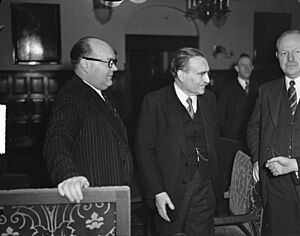
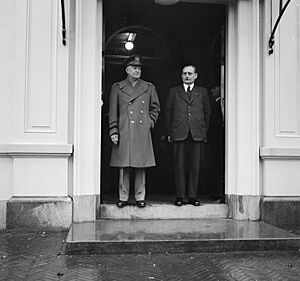
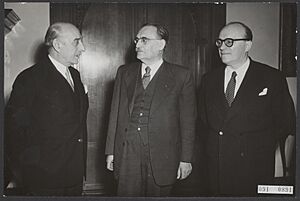
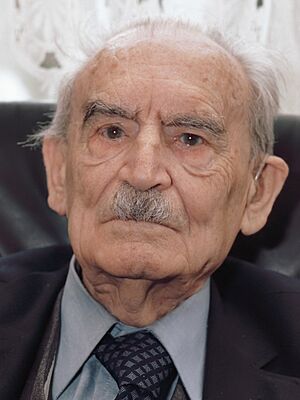
Political Journey
Joining Politics
In 1904, Drees joined the Social Democratic Workers' Party. This party later became part of the Labour Party in 1946. From 1910 to 1931, he led the party's branch in The Hague. He was also a member of The Hague's city council from 1913 to 1941. During this time, he worked as an alderman for social affairs and later for finance.
For many years, Drees was also a member of the Provincial Council of South Holland. He served in the House of Representatives from 1933 to 1940. From 1939, he was the leader of his party in the House.
World War II and After
During the German occupation of the Netherlands, Drees was taken as a hostage. He was held in the Buchenwald concentration camp and later at another camp. He was released in 1942 due to poor health. After his release, he played a key role in the secret resistance movement. He helped prepare the country for liberation.
After World War II ended, Drees became the Minister of Social Affairs and Deputy Prime Minister. This was in the Cabinet Schermerhorn–Drees, a government of national unity.
Leading the Country
From August 7, 1948, to December 22, 1958, Willem Drees was the Prime Minister of the Netherlands. He led four different governments during this time.
His time as Prime Minister saw many big changes in the Netherlands.
- Decolonization: The Dutch East Indies became independent as Indonesia.
- Economic Recovery: The country worked to rebuild after the war.
- Welfare State: New laws were made to help people. This included universal old-age pensions for everyone over 65. Health insurance was also expanded. Laws were passed to help families and disabled children.
- International Cooperation: The Netherlands joined new groups like Benelux, NATO, and the EEC. These groups helped countries work together for peace and trade.
Drees's government also dealt with challenges like the major North Sea flood of 1953. This flood caused a lot of damage and loss of life.
Many social improvements happened under Drees. For example, in 1950, works councils were created in companies. In 1957, it became illegal to fire female civil servants just because they got married. Housing laws were also updated to help with rebuilding and planning. Education also saw more funding and new laws, like the Nursery Education Act of 1955 for kindergartens.
Personal Life
On July 28, 1910, Willem Drees married Catharina Hent. They had two sons and two daughters. Both of his sons, Jan Drees and Willem Drees Jr., were also involved in the Labour Party. However, they left the party around 1970 because they disagreed with some younger members. Willem Drees himself also left the Labour Party in 1971, after being a member for almost 67 years.
Drees passed away on May 14, 1988, in The Hague, just two months before his 102nd birthday. For a period before his death, he was the oldest living former head of government in the world.
In 2004, he was voted third in the election for The Greatest Dutchman.
Honors and Awards
Willem Drees received many honors from the Netherlands and other countries. These awards recognized his important work and leadership.
| Honours | ||||
| Ribbon bar | Honour | Country | Date | Comment |
|---|---|---|---|---|
| Knight Grand Cross of the Order of the Netherlands Lion | Netherlands | 22 December 1958 | ||
| Grand Cross of the Order of Leopold | Belgium | 10 March 1949 | ||
| Grand Cross of the Order of the Dannebrog | Denmark | |||
| Knight Grand Cross of the Order of the Holy Trinity | Ethiopia | 3 November 1954 | ||
| Grand Cross of the Order of the Legion of Honour | France | 10 July 1954 | ||
| Grand Cross of the Royal Order of George I | Greece | 2 February 1954 | ||
| Grand Cross of the Order of the Star of Africa | Liberia | 10 December 1956 | ||
| Grand Cross of the Order of Adolphe of Nassau | Luxembourg | |||
| Grand Cross of the Order of the Oak Crown | Luxembourg | 12 July 1951 | ||
| Knight Grand Cross of the Royal Norwegian Order of St. Olav | Norway | |||
| Grand Cross of the Order of Vasa | Sweden | |||
| Knight Grand Cross (First Class) of the Order of the White Elephant | Thailand | 26 September 1955 | ||
| Knight Grand Cross of the Order of St Michael and St George | United Kingdom | 24 July 1958 | ||
| Medal of Freedom with Gold Palm | United States | 7 April 1953 | ||
| Honorific Titles | ||||
| Ribbon bar | Honour | Country | Date | Comment |
 |
Minister of State | Netherlands | 22 December 1958 | Style of Excellency |
Images for kids
-
The Grand Cross of the Belgian Order of Leopold awarded to Drees on during his visit to Brussels, on March 10, 1949 by Belgian Regent; Prince Charles, Count of Flanders.
-
The Imperial Ethiopian Order of the Holy Trinity, awarded to Drees by Emperor Haile Selassie during his state visit to the Netherlands on November 3, 1954.
-
Drees' insignia of the Grand Cross of the Legion d’Honneur given to him by President René Coty on July 10, 1954.
-
The Grand Cross of the Order of George I, awarded to Drees by Paul, King of the Greeks, in June 1954 on the occasion of the visit of the Prime Minister of Greece, Field Marshal Alexander Papagos, to the Netherlands on February 2, 1954.
-
The Grand Cross of the Order of the Star of Africa, awarded to Drees by William V.S. Tubman, President of Liberia, on December 10, 1956 on the occasion of his state visit to the Netherlands on October 15, 1956.
-
The Grand Cross of the Order of the Oak Crown, awarded to Drees by Charlotte, Grand Duchess of Luxembourg on July 12, 1951 on the occasion of the state visit of Queen Juliana and Prince Bernhard to Luxembourg from June 19-21, 1951.
-
The Grand Cross of the Order of the White Elephant, conferred on Drees by King Bhumipol Adulyadej of Thailand on September 26, 1955.
-
Drees' GCMG insignia awarded by Queen Elizabeth II during her state visit to the Netherlands, on July 24, 1958.
See also
 In Spanish: Willem Drees para niños
In Spanish: Willem Drees para niños



